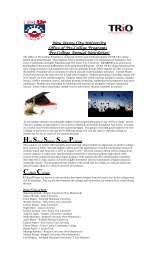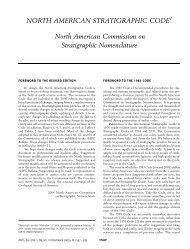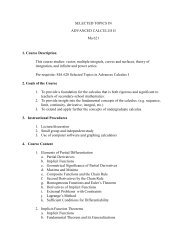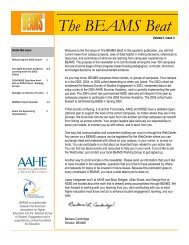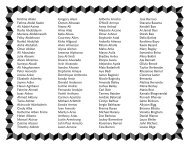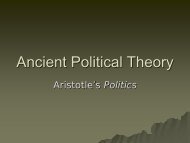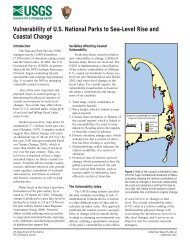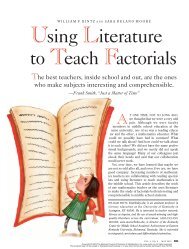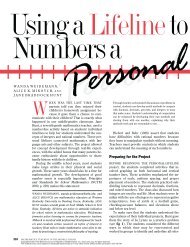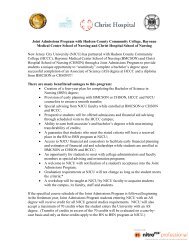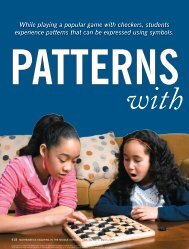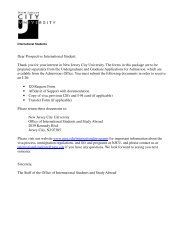Constructing complexity for differentiated learning.
Constructing complexity for differentiated learning.
Constructing complexity for differentiated learning.
You also want an ePaper? Increase the reach of your titles
YUMPU automatically turns print PDFs into web optimized ePapers that Google loves.
Fig. 6 Three levels of tasks working with linear equations<br />
Linear Equations in Two Variables<br />
For the equations below, tell whether<br />
the ordered pair is a solution to the<br />
given equation. Show why or why not.<br />
1. y = x + 2; (2, 4)<br />
2. y = −2x + 7; (−3, 1)<br />
3. x − 4y = 3; (7, 1)<br />
4. 3x + 2y = −4; (−3, 2)<br />
Linear Equations in Two Variables<br />
Find the value of b that makes the<br />
ordered pair a solution <strong>for</strong> the following<br />
equations.<br />
1. y = x + 2; (2, b)<br />
2. y = −2x + 7; (b, 1)<br />
3. x − 4y = 3; (7, b)<br />
4. 3x + 2y = −4; (b, 2)<br />
Linear Equations in Two Variables<br />
Find the value of b that makes the<br />
ordered pair a solution <strong>for</strong> the following<br />
equations.<br />
1. y = −2x + 7; (–b, 1)<br />
2. x − 4y = 3; (7, b − 5)<br />
3. 3x + 2y = −4; (7 − b, 2)<br />
5. The <strong>for</strong>mula y ≈ 2.6x changes<br />
the area x of a region in square miles<br />
to an approximate area y in square<br />
kilometers. The local wildlife preserve<br />
has an area of 768 square miles. Find<br />
the area of this preserve in square<br />
kilometers. Round your answer to the<br />
nearest square kilometer.<br />
5. The <strong>for</strong>mula y ≈ 2.6x changes the<br />
area x of a region in square miles<br />
to an approximate area y in square<br />
kilometers. The local wildlife preserve<br />
has an area of 1196 square kilometers.<br />
Find the area of this preserve in<br />
square miles. Round your answer to<br />
the nearest square mile.<br />
4. The <strong>for</strong>mula y ≈ 2.6x changes the<br />
area x of a region in square miles to an<br />
approximate area y in square kilometers.<br />
Write a <strong>for</strong>mula <strong>for</strong> finding the<br />
number of square miles given the number<br />
of square kilometers. Use this new<br />
<strong>for</strong>mula to find the area in square miles<br />
of a local wildlife preserve with an area<br />
of 1196 square kilometers. Round your<br />
answer to the nearest square mile.<br />
Write the following equations in function<br />
<strong>for</strong>m. Then solve <strong>for</strong> y in each<br />
problem if x = 2.<br />
6. y − x = −4<br />
7. 4x + 2y = 3<br />
8. x = 3y − 2<br />
Level 1<br />
Write the following equations in function<br />
<strong>for</strong>m. For each equation, give two<br />
ordered pairs that would be solutions.<br />
6. y − x = −4<br />
7. 4x + 2y = 3<br />
8. x = 3y − 2<br />
Level 2<br />
Write the following equations in function<br />
<strong>for</strong>m. For each equation, give two<br />
ordered pairs that would be solutions.<br />
5. 4x + 2y = 3<br />
6. x = 3y − 2<br />
7. Explain how it is possible to have<br />
more than one ordered-pair solution.<br />
Level 3<br />
is to break it into smaller tasks, which<br />
illuminate the more foundational steps<br />
needed to solve a more complex task.<br />
To make figure 2’s problem more<br />
accessible, a teacher might first give<br />
students two data sets of six values and<br />
a mean of 7 and ask them to find the<br />
mean and explain how it is possible to<br />
have two different sets with the same<br />
mean. Then, the teacher can guide the<br />
students to find a third set with the<br />
same mean.<br />
Existing foundational tasks can<br />
also be adjusted to make them more<br />
trans<strong>for</strong>mational, perhaps by asking<br />
students to generate their own data to<br />
meet certain constraints, make judgments,<br />
or work backward. Trans<strong>for</strong>mational<br />
tasks may also be presented<br />
through extension problems, such as<br />
this example involving figure 3:<br />
On grid paper, create a new version<br />
of the histogram with 10 miles as the<br />
interval <strong>for</strong> each bar. What in<strong>for</strong>mation<br />
is lost or gained? Can you<br />
answer the same questions from the<br />
new histogram? Why or why not?<br />
If some students who are given<br />
figure 3 need more practice interpreting<br />
histograms, this extension would<br />
be a reasonable activity <strong>for</strong> more advanced<br />
students in place of working on<br />
another foundational problem.<br />
PUTTING THE<br />
PIECES TOGETHER<br />
The sections above have highlighted<br />
ways to differentiate individual tasks<br />
through adjustments to particular<br />
problem characteristics. As teachers<br />
put these ideas together, one practical<br />
Vol. 15, No. 1, August 2009 ● Mathematics Teaching in the Middle School 41



